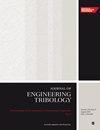Numerical solution of dry friction in point contact using the unified Reynolds method combined with rarefied gas effect
IF 1.8
3区 工程技术
Q3 ENGINEERING, MECHANICAL
Proceedings of the Institution of Mechanical Engineers, Part J: Journal of Engineering Tribology
Pub Date : 2023-10-26
DOI:10.1177/13506501231209557
引用次数: 0
Abstract
Dry friction problems are widespread in engineering applications. However, the current research on the contact pressure between interfaces mainly relies on static contact mechanics solutions, neglecting the influence of the contact pressure generated by the gases in the environment. In this paper, the ambient gas is considered as a lubricant with lubricating effects. Drawing inspiration from hydrodynamic lubrication methods, a unified mixed lubrication equation for dry friction problems is developed, taking into account the influence of gas rarefaction effects. This study computes the dry friction contact pressure under different winding speeds and loads. The advantage of this method lies in its ability to automatically distinguish between the contact and noncontact regions during the calculation process, enabling the determination of the contact pressure over the entire contact area. The computational results demonstrate that at low entrainment velocities, there is minimal deviation in contact pressure and contact area compared to Hertzian contact. However, as the entrainment velocity increases, the actual pressure-bearing area enlarges compared to static contact, and there is a smooth transition of pressure at the contact edge, which cannot be obtained from static contact analysis. Finally, the numerical solution of the contact pressure when the sliding speed spans several orders of magnitude is given, and the calculation results show that the numerical model has good robustness. This numerical approach offers valuable insights for guiding the design of air bearings in practical applications.结合稀薄气体效应的统一雷诺法点接触干摩擦数值解
干摩擦问题在工程应用中广泛存在。然而,目前对界面接触压力的研究主要依赖于静态接触力学解,忽略了环境中气体产生的接触压力的影响。本文将环境气体视为具有润滑作用的润滑剂。受流体动力润滑方法的启发,考虑气体稀薄效应的影响,建立了干摩擦问题的统一混合润滑方程。本文计算了不同缠绕速度和载荷下的干摩擦接触压力。该方法的优点在于能够在计算过程中自动区分接触区域和非接触区域,从而确定整个接触区域的接触压力。计算结果表明,与赫兹接触相比,在低夹带速度下,接触压力和接触面积偏差最小。但随着夹带速度的增大,实际承压面积较静接触增大,且接触边缘存在平滑的压力过渡,这是静接触分析无法得到的。最后给出了滑动速度跨越几个数量级时接触压力的数值解,计算结果表明该数值模型具有较好的鲁棒性。这种数值方法为指导实际应用中空气轴承的设计提供了有价值的见解。
本文章由计算机程序翻译,如有差异,请以英文原文为准。
求助全文
约1分钟内获得全文
求助全文
来源期刊

CiteScore
4.20
自引率
5.00%
发文量
110
审稿时长
6.1 months
期刊介绍:
The Journal of Engineering Tribology publishes high-quality, peer-reviewed papers from academia and industry worldwide on the engineering science associated with tribology and its applications.
"I am proud to say that I have been part of the tribology research community for almost 20 years. That community has always seemed to me to be highly active, progressive, and closely knit. The conferences are well attended and are characterised by a warmth and friendliness that transcends national boundaries. I see Part J as being an important part of that community, giving us an outlet to publish and promote our scholarly activities. I very much look forward to my term of office as editor of your Journal. I hope you will continue to submit papers, help out with reviewing, and most importantly to read and talk about the work you will find there." Professor Rob Dwyer-Joyce, Sheffield University, UK
This journal is a member of the Committee on Publication Ethics (COPE).
 求助内容:
求助内容: 应助结果提醒方式:
应助结果提醒方式:


